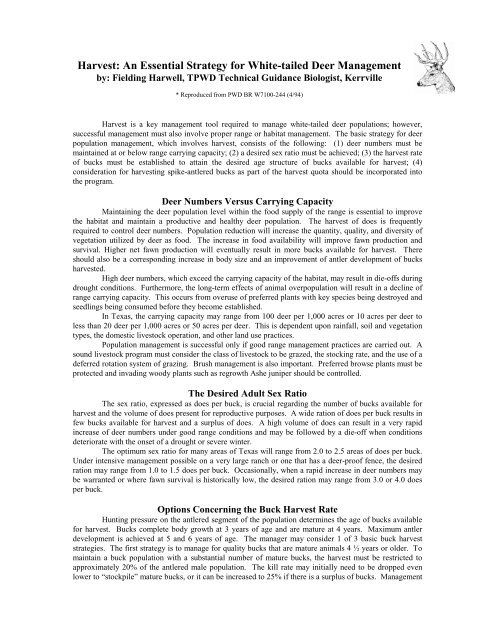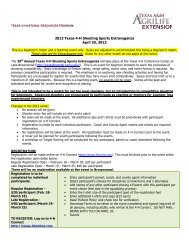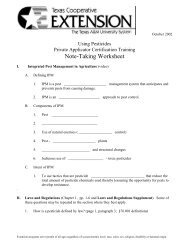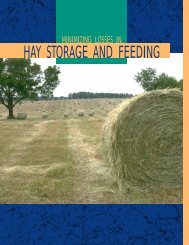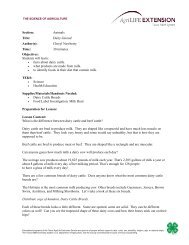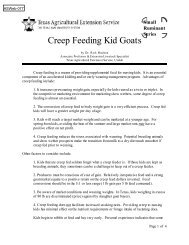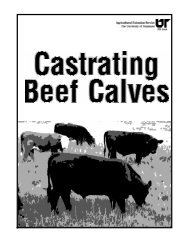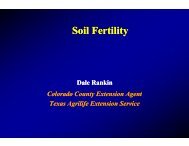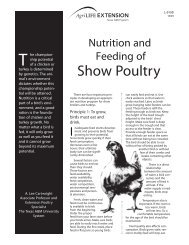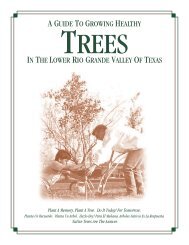Harvest: An Essential Strategy for White-tailed Deer Management
Harvest: An Essential Strategy for White-tailed Deer Management
Harvest: An Essential Strategy for White-tailed Deer Management
You also want an ePaper? Increase the reach of your titles
YUMPU automatically turns print PDFs into web optimized ePapers that Google loves.
<strong>Harvest</strong>: <strong>An</strong> <strong>Essential</strong> <strong>Strategy</strong> <strong>for</strong> <strong>White</strong>-<strong>tailed</strong> <strong>Deer</strong> <strong>Management</strong>by: Fielding Harwell, TPWD Technical Guidance Biologist, Kerrville* Reproduced from PWD BR W7100-244 (4/94)<strong>Harvest</strong> is a key management tool required to manage white-<strong>tailed</strong> deer populations; however,successful management must also involve proper range or habitat management. The basic strategy <strong>for</strong> deerpopulation management, which involves harvest, consists of the following: (1) deer numbers must bemaintained at or below range carrying capacity; (2) a desired sex ratio must be achieved; (3) the harvest rateof bucks must be established to attain the desired age structure of bucks available <strong>for</strong> harvest; (4)consideration <strong>for</strong> harvesting spike-antlered bucks as part of the harvest quota should be incorporated intothe program.<strong>Deer</strong> Numbers Versus Carrying CapacityMaintaining the deer population level within the food supply of the range is essential to improvethe habitat and maintain a productive and healthy deer population. The harvest of does is frequentlyrequired to control deer numbers. Population reduction will increase the quantity, quality, and diversity ofvegetation utilized by deer as food. The increase in food availability will improve fawn production andsurvival. Higher net fawn production will eventually result in more bucks available <strong>for</strong> harvest. Thereshould also be a corresponding increase in body size and an improvement of antler development of bucksharvested.High deer numbers, which exceed the carrying capacity of the habitat, may result in die-offs duringdrought conditions. Furthermore, the long-term effects of animal overpopulation will result in a decline ofrange carrying capacity. This occurs from overuse of preferred plants with key species being destroyed andseedlings being consumed be<strong>for</strong>e they become established.In Texas, the carrying capacity may range from 100 deer per 1,000 acres or 10 acres per deer toless than 20 deer per 1,000 acres or 50 acres per deer. This is dependent upon rainfall, soil and vegetationtypes, the domestic livestock operation, and other land use practices.Population management is successful only if good range management practices are carried out. Asound livestock program must consider the class of livestock to be grazed, the stocking rate, and the use of adeferred rotation system of grazing. Brush management is also important. Preferred browse plants must beprotected and invading woody plants such as regrowth Ashe juniper should be controlled.The Desired Adult Sex RatioThe sex ratio, expressed as does per buck, is crucial regarding the number of bucks available <strong>for</strong>harvest and the volume of does present <strong>for</strong> reproductive purposes. A wide ration of does per buck results infew bucks available <strong>for</strong> harvest and a surplus of does. A high volume of does can result in a very rapidincrease of deer numbers under good range conditions and may be followed by a die-off when conditionsdeteriorate with the onset of a drought or severe winter.The optimum sex ratio <strong>for</strong> many areas of Texas will range from 2.0 to 2.5 areas of does per buck.Under intensive management possible on a very large ranch or one that has a deer-proof fence, the desiredration may range from 1.0 to 1.5 does per buck. Occasionally, when a rapid increase in deer numbers maybe warranted or where fawn survival is historically low, the desired ration may range from 3.0 or 4.0 doesper buck.Options Concerning the Buck <strong>Harvest</strong> RateHunting pressure on the antlered segment of the population determines the age of bucks available<strong>for</strong> harvest. Bucks complete body growth at 3 years of age and are mature at 4 years. Maximum antlerdevelopment is achieved at 5 and 6 years of age. The manager may consider 1 of 3 basic buck harveststrategies. The first strategy is to manage <strong>for</strong> quality bucks that are mature animals 4 ½ years or older. Tomaintain a buck population with a substantial number of mature bucks, the harvest must be restricted toapproximately 20% of the antlered male population. The kill rate may initially need to be dropped evenlower to “stockpile” mature bucks, or it can be increased to 25% if there is a surplus of bucks. <strong>Management</strong>
<strong>for</strong> mature quality bucks is practical when there is light hunting pressure, the ranch has a high fence, or alarge tract of land is involved in the program. A disadvantage of this type program is possible loss of bucksdue to natural mortality, accidental death, or illegal harvest.A second strategy is to furnish maximum recreation by harvesting 40% to 50% of the estimatedbuck population. The harvest quota will depend upon reproduction and the volume of replacement bucksfrom the fawn segment of the population. Under this harvest strategy, 75% to 85% of the bucks harvestedwill be young deer in the 1 ½ and 2 ½ year old age classes. In areas subject to heavy hunting pressurebecause of small landownership size, this may be a practical option.The third option is an optional harvest rate of 30% to 33% of the estimated buck population. Thisoption is between the limited harvest required to produce mature quality bucks and the maximum harvest of50%. The 30% harvest rate furnishes greater volume of bucks to be harvested than the quality strategy ofharvesting 20%; also, it provides <strong>for</strong> a greater number of older age deer than does the maximum harvest rateof 50%.<strong>Harvest</strong> of Spike-<strong>An</strong>tlered BucksThe harvest of spike-antlered bucks is another important aspect of a management program. Spikeantleredbucks are the result of inadequate nutrition, age, and genetics, or combination of these factors.Spikes are generally found in the yearling or 1 ½ year old age class; however, yearling bucks can produce 4to 8 points if nutrition is adequate. For nutrition to be adequate, deer numbers must be in balance with thehabitat, competition with livestock must be minimal, and rainfall adequate. Additionally, research hasshown that on the average, spike-antlered yearling bucks will remain inferior to <strong>for</strong>k-antlered yearling buckswhen these two groups reach maturity. Consequently, spike-antlered bucks may be considered as part of thebuck harvest quota. This permits the removal of poor quality bucks at an early age and it reduces huntingpressure on the more desirable bucks. The recommended spike buck harvest may comprise up to one-halfof the buck harvest quota depending on how much the manager wants to reduce hunting pressure on betterquality bucks and reduce numbers of spike bucks. <strong>An</strong> unlimited harvest of spike-antlered bucks is practicalonly under very intensive management. Importantly, the manager must remember that a high incidence ofspike-antlered bucks is a symptom of rangeland overpopulated with deer and/or overstocked with domesticanimals. These factors that limit deer quality must be corrected be<strong>for</strong>e the selective harvest of spike bucksis beneficial to the program.In Closing<strong>Harvest</strong> plays a major role in the management of a white-<strong>tailed</strong> deer population; however, basicrange management practices that concern domestic livestock must be implemented. These combinedmanagement practices are required to increase the quantity, quality, and diversity of range plants needed tosupport a productive and healthy deer population.


